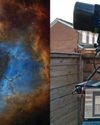
You feel the vibrations as the rocket lifts off from the launch pad. This cramped spaceship is your home for two years as you journey all the way out to Jupiter, the Solar System's largest planet. It's so far away that when you get there the Sun's light is a mere 1/25th as bright as on Earth.
And yet, if you were to make a journey of the same distance in some planetary systems, you'd still be inside the star. These celestial beasts - known as hypergiant stars - are colossal. The biggest can fit 10 billion Suns inside, or 14 quadrillion Earths.
Such monsters are rare, but they play a crucial role in seeding the Universe with the rich array of chemistry required to sustain life. Their scarcity means they've been poorly understood in the past, but a run of recent research is giving astronomers unprecedented insights into their unique behaviour. Soon we may know their secrets.
Bizarre behemoths
Hypergiants are so massive, typically dozens of times the mass of the Sun or more, that they are highly unstable. They regularly cough huge quantities of their material back into space. "They are throwing out the mass of Jupiter or more in a single event," says Roberta Humphreys, an astrophysicist at the University of Minnesota.
A similar event on a smaller scale unfolded on the supergiant star Betelgeuse in 2019, when it dimmed noticeably in the night sky before brightening again. Painstaking analysis concluded that it spat out material weighing several times the mass of the Moon from its southern hemisphere. That material blocked out some of Betelgeuse's light, causing the temporary dimming. It was the first time astronomers had seen such a huge ejection from the surface of a star in real time.
Esta historia es de la edición May 2023 de BBC Sky at Night Magazine.
Comience su prueba gratuita de Magzter GOLD de 7 días para acceder a miles de historias premium seleccionadas y a más de 9,000 revistas y periódicos.
Ya eres suscriptor ? Conectar
Esta historia es de la edición May 2023 de BBC Sky at Night Magazine.
Comience su prueba gratuita de Magzter GOLD de 7 días para acceder a miles de historias premium seleccionadas y a más de 9,000 revistas y periódicos.
Ya eres suscriptor? Conectar

Putting cosmic rays to work
These penetrating interstellar particles have applications from astronomy to archaeology

Set up your first imaging sequence
How to automate and coordinate your gear over multiple nights of imaging

The Universe without gravity
Life with no gravity might sound a fun idea, but as Govert Schilling explains, shutting off this pivotalforce would spell disaster for Earth and beyond

How to blend images taken with different camera setups
Combine data captured at varied focal lengths to create rich, deep images

INSIDE THE SKY AT NIGHT
Back in September 2021, The Sky at Night show spoke to Carly Howett about NASA's then upcoming Lucy mission. As the spacecraft now approaches its main targets - the Trojan asteroids - we check in with her to see how the mission is going

The science of SCI-FI
We love a good sci-fi film, but do they get the science right? Amy Arthur picks six of the big mistakes made in space films

Seeing in a new light
It's National Astronomy Week this month, so take a tip from Mark Westmoquette and let mindful stargazing change your perspective on your life and problems

What to do if you find a meteorite
Ever come across an unusual rock and wondered if it's a meteorite? Mark McIntyre explains how to tell if that stone really is a fragment from outer space

GEAR
Charlotte Daniels rounds up the latest astronomical accessories

Q&A WITH A STELLAR ECLIPSE SPECIALIST
Many stars are gravitationally locked inside multi-star systems, but a rare new triple-star system has set a new record for how cosy these clusters can get